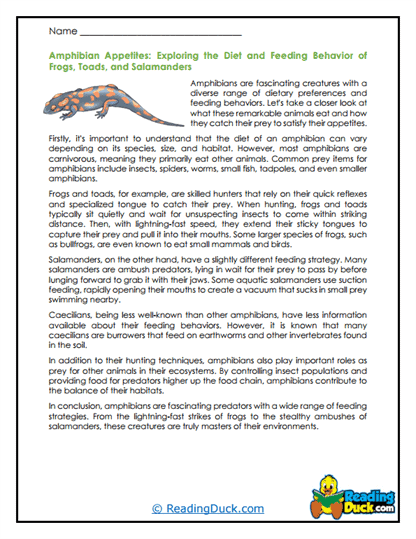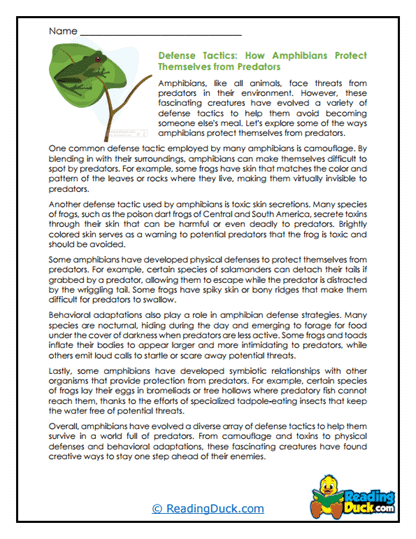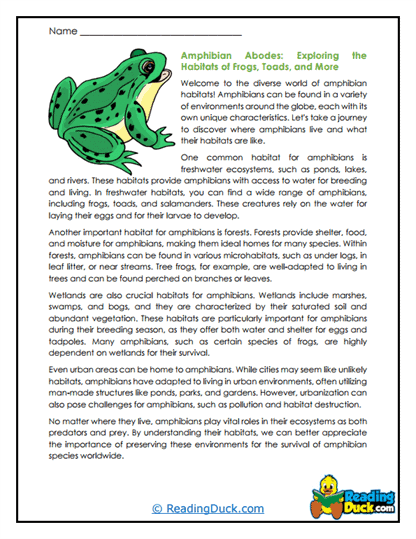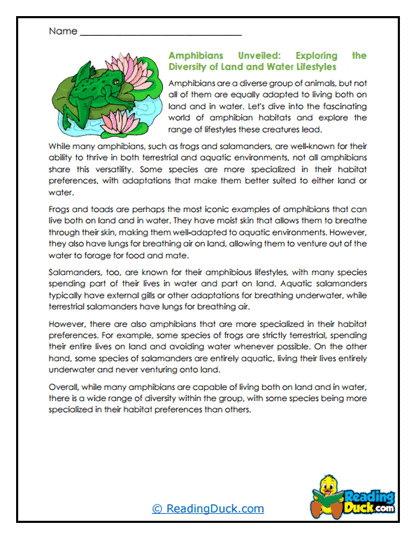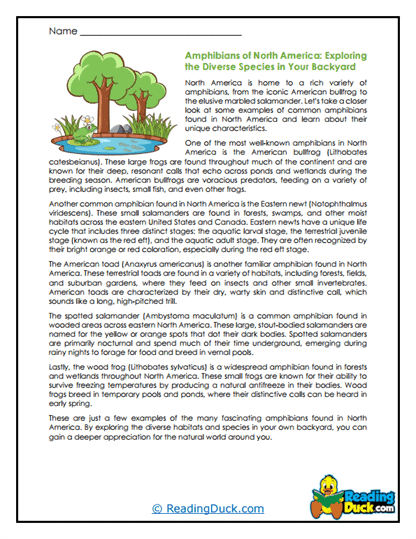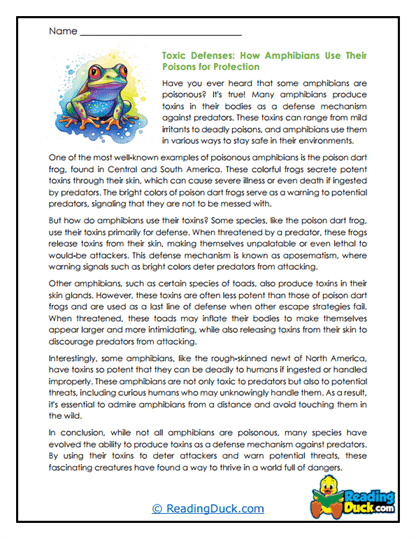Amphibians Worksheets
About Our Amphibians Worksheets
Our collection of Amphibians worksheets offers an engaging and educational dive into the fascinating world of amphibians, making it a valuable resource within the broader categories of Science: Biology and Animals. Amphibians are unique creatures that bridge the gap between aquatic and terrestrial life, making them a compelling topic for study. These worksheets are designed to help students explore the life cycles, habitats, and behaviors of amphibians while encouraging critical thinking and personal reflection.
This collection contains several worksheet sets, each structured to provide a comprehensive learning experience. Every worksheet set includes:
- Multiple Choice Questions: These questions assess students' comprehension of the reading passage, ensuring they understand the key concepts and details.
- Short Answer Questions: This section prompts students to write their responses, encouraging them to express their understanding in their own words. This practice reinforces their knowledge and helps improve their ability to communicate scientific information effectively.
- Open-Ended Questions: These questions invite students to share their personal thoughts, opinions, and reflections on the material, fostering critical thinking and allowing them to connect more deeply with the content.
Each worksheet is accompanied by a detailed answer key, making it easy for educators and parents to review students' work. The worksheets are provided in PDF format, ensuring they can be easily viewed electronically, downloaded, and printed.
Amphibians: The Journey from Water to Land
When introducing students to the topic of amphibians, it’s important to start with an overview of what amphibians are and why they are significant in the study of Biology. Amphibians are a group of cold-blooded vertebrates that live part of their lives in water and part on land. This dual lifestyle is one of their most defining characteristics, and it plays a crucial role in their development, behavior, and ecological roles.
To help students gain a comprehensive understanding of amphibians, we can explore the topic through the following key areas:
Types of Amphibians: Amphibians can be divided into three main groups, each with unique features and behaviors:
- Frogs and Toads: Frogs and toads are perhaps the most familiar amphibians. They are known for their powerful hind legs, which allow them to jump great distances, and their distinctive life cycle, which includes metamorphosis from a tadpole to an adult. Frogs generally have smooth, moist skin and are more likely to be found near water, while toads have drier, bumpier skin and can often be found farther from water sources.
- Salamanders and Newts: Salamanders and newts are more elongated and lizard-like in appearance, with long tails and smooth, moist skin. They are often found in damp environments, such as under logs or near streams. Unlike frogs, salamanders and newts typically retain their tails throughout their lives.
- Caecilians: Caecilians are less well-known but no less fascinating. These limbless, worm-like amphibians live primarily underground or in water. They have a unique way of life, often burrowing through soil or mud and using their keen sense of smell to find prey.
Life Cycle of Amphibians: Amphibians undergo a remarkable transformation known as metamorphosis, which is one of the most distinctive aspects of their biology:
- Egg Stage: Amphibians typically lay their eggs in water, where the eggs are surrounded by a jelly-like substance that protects them from predators and environmental conditions.
- Larval Stage (Tadpoles): After hatching, amphibian larvae, known as tadpoles in frogs and toads, live entirely in water. They breathe through gills and have tails for swimming. During this stage, they feed on algae and plant material.
- Metamorphosis: As tadpoles grow, they undergo metamorphosis, during which they develop legs, lose their tails, and transition from gills to lungs. This transformation allows them to move from an aquatic to a terrestrial environment.
- Adult Stage: In their adult form, amphibians can live both on land and in water. They continue to return to water to breed, ensuring the continuation of their life cycle.
Habitat and Adaptations: Amphibians are highly adapted to a range of environments, although they are most commonly found in moist or aquatic habitats:
- Moist Skin: Amphibians have permeable skin that allows them to absorb water and oxygen directly from their environment, which is why they are often found in humid or wet areas.
- Camouflage and Defense Mechanisms: Many amphibians use camouflage to avoid predators, blending into their surroundings with the help of their skin color and texture. Some species also produce toxins as a defense mechanism, making them unpalatable or dangerous to potential predators.
- Temperature Regulation: As ectothermic (cold-blooded) animals, amphibians rely on their environment to regulate their body temperature. They often bask in the sun to warm up or retreat to cool, shaded areas to avoid overheating.
Ecological Role: Amphibians play a critical role in their ecosystems, serving as both predators and prey:
- Predators: Amphibians are effective predators, feeding on insects, small invertebrates, and even other amphibians. Their diet helps control insect populations, making them important contributors to ecological balance.
- Prey: Amphibians are also an important food source for a variety of animals, including birds, mammals, reptiles, and fish. Their presence in the food web is essential for the survival of many other species.
- Indicator Species: Because of their permeable skin and dual life cycle, amphibians are highly sensitive to environmental changes, such as pollution, habitat destruction, and climate change. This makes them valuable indicator species, helping scientists monitor the health of ecosystems.
Conservation and Threats: Amphibians are facing numerous threats that have led to significant declines in their populations worldwide:
- Habitat Loss: Deforestation, wetland drainage, and urbanization are some of the primary causes of habitat loss for amphibians. Without suitable environments to live and breed, their populations cannot sustain themselves.
- Pollution: Chemicals in the environment, such as pesticides and industrial pollutants, can be absorbed through amphibians’ skin, leading to health problems and population declines.
- Climate Change: Changes in temperature and precipitation patterns can disrupt amphibian breeding cycles and reduce the availability of suitable habitats.
- Disease: Amphibians are particularly vulnerable to diseases such as chytridiomycosis, a fungal infection that has decimated amphibian populations worldwide.
By exploring these aspects of amphibians, students can develop a well-rounded understanding of these unique and important creatures. These worksheets will guide them through the biology and ecology of amphibians, sparking curiosity and encouraging them to think critically about the role amphibians play in the natural world.
Where to Use These Worksheets
Integrating our Amphibians worksheets into a school or homeschool curriculum provides numerous opportunities to enhance students' understanding of Biology and the animal kingdom. Here are some practical ideas on how educators and parents can effectively use these worksheets in various educational settings:
- Unit-Based Learning: These worksheets can be used as part of a broader unit on Biology or Life Sciences. After introducing students to basic biological concepts such as ecosystems, life cycles, and adaptation, the topic of amphibians can be explored in greater depth using these worksheets. The worksheets can serve as the foundation for discussions, experiments, and further research on amphibians and their significance in ecosystems.
- Classroom Discussions and Group Activities: Encourage students to work in pairs or small groups to discuss the reading passages and answer the questions together. This collaborative approach helps students articulate their thoughts, listen to different perspectives, and deepen their understanding of the material. The open-ended questions, in particular, are excellent for sparking class discussions, where students can share their ideas and engage in debates about the importance of amphibians in biodiversity and conservation.
- Research Projects and Presentations: After completing the worksheets, students can be assigned to research and present on specific amphibians or topics related to amphibians, such as the life cycle of a frog, the adaptations of salamanders, or the conservation status of endangered amphibian species. They can also explore topics like the impact of climate change on amphibian populations or the role of amphibians as indicator species. These projects can culminate in presentations, reports, or creative displays, allowing students to showcase their knowledge and enthusiasm for the subject.
- Multimedia Integration: Pair the worksheets with multimedia resources to create a more immersive learning experience. For example, students can watch documentaries or educational videos on amphibian behavior, habitats, or conservation efforts before completing the worksheets. This combination of visual and textual learning can cater to different learning styles and reinforce the concepts covered in the worksheets.
- Homework Assignments: The worksheets are ideal for homework assignments, giving students the opportunity to engage with the material independently. The reading passages and questions are designed to be both challenging and accessible, making them perfect for self-directed study. The answer key allows for easy review, helping students to check their understanding and correct any misconceptions.
- Field Trips and Observation Activities: Organize a field trip to a local wetland, pond, or nature reserve where students can observe amphibians in their natural habitat. Before the trip, use the worksheets to educate students about the amphibians they may encounter and what to look for in terms of behavior and adaptations. After the trip, have students complete the worksheets to reflect on their experience and connect it to what they've learned.
By incorporating these Amphibians worksheets into the curriculum, teachers and parents can provide students with a comprehensive and engaging learning experience. These worksheets are designed to help students explore the biology and ecology of amphibians, develop critical thinking skills, and foster a lifelong curiosity about the natural world. Whether used in the classroom or at home, these resources will inspire students to appreciate the unique adaptations and ecological roles of amphibians, as well as the importance of their conservation.
